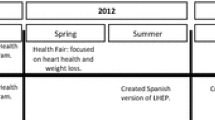Abstract
A description of the use of indigenous lay health educators as they participated in the implementation of a community-based smoking cessation program is provided. The target population was young black women who resided in several urban public housing developments. The intervention, which was conducted in tandem with a larger televised smoking cessation program, consisted of either class sessions conducted by or reminder visits from community lay health educators. The lay health educators were successful in organizing this population, often viewed as difficult to reach, to become more aware of the dangers of smoking and to become more interested in participating in a structured smoking cessation program. They motivated 235 individuals to sign up for the program; of these, 141 attended at least one class session or accepted at least an initial reminder visit. The results suggest that lay health educators may be able to mobilize this population to participate in health promotion programs. However, due to differences in this population related to smoking, the findings indicate that new methods must be developed for sustaining their involvement after they have been reached.
Similar content being viewed by others
References
U.S. Department of Health and Human Services:Reducing the Health Consequences of Smoking: 25 Years of Progress: A Report of the Surgeon General. DHHS Publication No. (CDC) 89-8411. Rockville, MD: Office of Smoking and Health, Centers for Disease Control, 1989.
Gritz, ER: Cigarette Smoking: The need for action by health professional.CA 38:194–212, 1988.
U.S. Department of Health and Human Services:Cancer among Blacks and Other Minorities: Statistical Profiles. NIH Publication No. 86-2785. Washington, DC: Govt Printing Office, 1986.
U.S. Department of Health and Human Services:Report of the Secretary's Task Force on Black and Minority Health. Volume III: Cancer. DHHS Publication No. 86-0017. Washington, DC: Govt Printing Office, 1986.
Novotny, TE, Warner, KE, Kendrick, JS, Remington, PL: Smoking by blacks and whites: Socioeconomic and demographic differences.Amer J Public Health 78:1187–1189, 1988.
Orleans, CT, Schoenbach, V, Salmon, M, et al.: A survey of smoking and quitting patterns among black Americans.Amer J Public Health 79:176–180, 1989.
Fiore, MJ, Novotny, TE, Pierce, JP, Hatziandreu, EJ, Patel, KM, Davis, RM: Trends in cigarette smoking in the United States: The changing influence of gender and race.JAMA 261:49–55, 1989.
U.S. Department of Health and Human Services:The Health Consequences of Smoking: Nicotine Addiction: A Report of the Surgeon General. DHHS Publication No. (CDC) 88-8406, Rockville, MD: Office on Smoking and Health, Centers for Disease Control, 1988.
Flay, BR:Selling the Smokeless Society. Washington, DC: American Public Health Association, 1987.
Gottlieb, N, Green, L: Ethnicity and lifestyle health risk: Some possible mechancisms.Amer J Health Promotion, Summer:37–45,51, 1987.
Pierce, JP, Fiore, MC, Novotny, TE, Hatziandreu, EJ, Davis, RM: Trends in cigarette smoking in the United States: Projections to the year 2000.JAMA 261:61–65, 1989.
Freimuth, VS, Mettger, W: Is there a hard-to-reach audience?Public Health Rep 105:232–238, 1990.
Manfredi, C, Lacey, L: Smoking cessation strategies among urban low-income black women. Unpublished baseline data, 1987.
Warnecke, RB, Flay, BR, Kviz, FJ, et al.: Characteristics of participants in a televised smoking cessation intervention.Prev Med, 20:389–403, 1991.
Rogers, EM:Diffusion of Innovations. New York: Free Press, 1983.
Farquhar, J, Maccoby, N, Wood, P: Education and communication studies. In W Holland, B Detels, G Knox (Eds.),Oxford Textbook of Public Health. London: Oxford University Press, 1985, Vol. 3, pp. 207–221.
Flora, JA, Farquhar, JW: Methods of message design: Experiences from the Stanford Five City Project.Scand J Prim Health Care, Suppl 1, 39–47, 1988.
Maccoby, N, Solomon, DS: Heart disease prevention: Community studies. In RE Rice, WF Paisley (Eds.),Public Communication Campaigns. Beverly Hills, CA: Sage, 1981.
Warnecke, RB, Graham, S, Mosher, W, Montgomery, EB, Schotz, W: Contact with health guides and use of health services among blacks in Buffalo.Public Health Rep 90:213–222, 1975.
Misczynski, M, Stern, E: Detection of cervical and breast cancer: A community-based pilot study.Med Care 17: 304–313, 1979.
Katz, E, Lazarsfeld, PF:Personal Influence: The Part Played by People in the Flow of Mass Communications. Glencoe, IL: Free Press, 1955.
Warnecke, RB, Graham, S, Mosher, W, Montgomery, EB: Health guides as influentials in Central Buffalo.J Health Soc Behav 17:22–34, 1976.
Block, C: Communicating with the urban poor: An exploratory inquiry.Journalism Quart 47:3–11, 1970.
Greenberg, B, Dervin, B:Use of the Mass Media by the Urban Poor. New York: Praeger, 1970.
Manfredi, C, Lacey, L, Warnecke, R, Buis, M: Smoking-related behavior, beliefs and social environment of young low-income, urban black female smokers residing in subsidized public housing. Unpublished manuscript, 1990.
Manfredi, C, Lacey, L, Warnecke, R: Results of an intervention to improve compliance with referrals for evaluation of suspected malignancies at neighborhood public health centers.Amer J Public Health 80:85–87, 1990.
Lacey, L, Manfredi, C, Balch, G, Allen, K. Warnecke, R: Social support for low-income black women smokers: Insights from focus-group findings. Unpublished manuscript, 1990.
Author information
Authors and Affiliations
Additional information
Loretta Lacey, RN, Dr PH., is Associate Professor, Community Health Sciences, School of Public Health, University of Illinois at Chicago, Chicago, Illinois; Sheila Tukes, MA, is former Project Coordinator, Center for Urban Affairs and Policy Research, Northwestern University, Evanston, Illinois; Clara Manfredi, PhD, is Associate Director for Special Populations, Prevention Research Center, School of Public Health, University of Illinois at Chicago; and Richard B. Warnecke, PhD, is Director, Survey Research Laboratory, and Professor of Sociology and Epidemiology-Biostatistics, University of Illinois at Chicago.
Supported by Grant CA42760 from the National Cancer Institute, Department of Health and Human Services. We thank Robert Michielutte, PhD, Department of Community Medicine, Bowman Gray School of Medicine, for his critical review and comments on the manuscript. Appreciation is expressed to Mary A. Spaeth for editorial review.
Rights and permissions
About this article
Cite this article
Lacey, L., Tukes, S., Manfredi, C. et al. Use of lay health educators for smoking cessation in a hard-to-reach urban community. J Community Health 16, 269–282 (1991). https://doi.org/10.1007/BF01320335
Issue Date:
DOI: https://doi.org/10.1007/BF01320335




